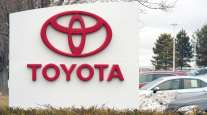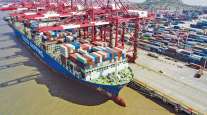Truck Market Becomes More Global, Intensifying Competition, Execs Say
This story appears in the Jan. 24 print edition of Transport Topics.
LAS VEGAS — The dynamic heavy-duty truck market is becoming more closely connected globally, with manufacturers of parts, components and whole vehicles competing fiercely worldwide while more national governments impose significant regulations on carbon dioxide emissions, industry executives said.
At a heavy-duty industry event here Jan. 17, executives and consultants also spoke about CO2 regulations that will be more significant than were efforts to eliminate nitrogen oxide and particulate matter emissions.
They also discussed low-cost trucks with Asian components, some of which will be assembled and sold in North America, and substantial business opportunities for U.S. manufacturers in China and India. They said that what was once dismissed as “the rest of the world” is now most of the world, not just in terms of population but even in the realm of truck making.
“We as an industry can’t be arrogant. We must recognize the challenges from developing countries,” said Jack Shaffer, chief operating officer of Bergstrom Inc. and the new chairman of the Heavy-Duty Manufacturers Association.
“You have to recognize how much is going on in Asia. We have operations in India and China, and you just have to be there,” said Joe McAleese, CEO of Bendix Commercial Vehicle Systems.
Frost & Sullivan consultants Sandeep Kar and Ryan Carmichael said the production of inexpensive but sturdy, low-cost trucks is rising worldwide and that North American companies would assemble and sell some of them (1-17, p. 4).
While the cheapest will stay in China, India and the developing world, Kar said U.S. and Canadian fleets could see Class 8 tractors priced for less than $90,000 each, compared to the typical $120,000 today.
“This is not about making cheap trucks; it’s about making trucks cheaply,” Kar said.
Kar discussed his study as part of a panel presentation moderated by Howard Abramson, Transport Topics’ editorial director and publisher.
American Truck Dealers Chairman Kyle Treadway, who sells state-of-the-art Kenworth trucks, said after listening to the F&S presentation that there definitely is “an appetite” in the U.S. market for a much simpler and less costly tractor.
“There are truck buyers who look mainly at price and are focused on the bottom line. They don’t care much about image,” said Treadway, adding that reliability and quality are still of great importance. Even if a fleet does not go all low-cost in its tractor buying, Treadway said, he can easily imagine customers buying some of the vehicles for selected applications.
“They might diversify with a dollar-conscious division and then traditional trucks for an owner-operator division,” he suggested.
Consultants Hans Lehmann and Elmar Kades of Alix Partners said the truck production in Brazil, Russia, India and China now makes up two-thirds of the world total.
Lehmann said companies in those four nations sell trucks at home and export them to Africa, Central America, the Middle East and Southeast Asia. He said Chinese production has grown continuously over the past 10 years, with improving quality.
“The 1980s and ’90s were marked by low-cost trucks of poor quality,” Lehmann said of the Chinese market, “but since 2000, they have produced in a strongly growing ‘middle segment’ ” of good vehicles that are priced attractively.
Juergen Reers, managing partner of Roland Berger Strategy Consultants, offered advice on how to deal with the prospect of carbon dioxide regulations in North America, Western Europe and Japan.
“We need incentives for early adoption” of technologies and systems by fleets, Reers said, adding that “CO2 regulations will also spread to countries beyond the Triad.”
HDMA’s Shaffer called the U.S. efforts to reduce CO2 emissions “the most significant regulation on our industry in its history,” including the 2002, 2007 and 2010 tightening of NOx and PM emissions.
Reers estimated that carbon emissions by U.S. highway tractors could be cut 21% to 42% by 2020, but it would take a comprehensive approach affecting truck engines, powertrains, chassis, trailers and alternative fuels.
“This will be a significant shift, a sea change, but the solutions will involve much complexity with numerous technologies,” Reers said.
In addition to forecasts of tumult to come, key executives from Eaton Corp., Hendrickson International and Williams Controls said they have been pleased with ventures in China and India but that working there can be as difficult as it is necessary.
Kenneth Davis, president of Eaton’s global vehicle group, said his company tried to sell in India and got close on a number of deals, but was always rebuffed until Eaton built a plant there.
“People want to see you make a commitment to their region,” Davis said.
Williams Controls CEO Patrick Cavanagh warned that Chinese truck makers he supplies sometimes won’t pay for products and often pay slowly. He also said it is important to find numerous local managers who speak English, rather than to rely on a single general manager who is the only English speaker on site.
Gary Gerstenslager, CEO of suspension maker Hendrickson, said he is resigned to the Chinese copying products he makes there but that the crucial task is to protect the products he sells in his core North American market.



